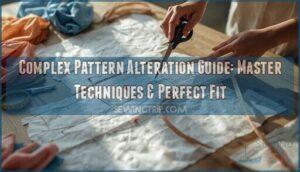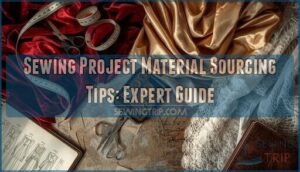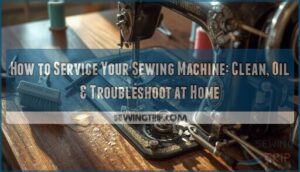This site is supported by our readers. We may earn a commission, at no cost to you, if you purchase through links.

Cotton breathes well for long convention days, while polyester resists wrinkles and maintains vibrant colors.
Spandex adds essential stretch for superhero suits, and vinyl creates those perfect futuristic finishes.
Blended fabrics combine natural comfort with synthetic durability – your sweet spot for all-day wear.
Always pre-wash fabrics to prevent shrinkage disasters, and match fabric weight to your character’s status.
Heavy materials suggest armor or nobility, while lightweight options work for flowing capes.
Your fabric choice affects everything from comfort to authenticity, and mastering specific techniques for different materials achieves professional-looking results.
Understanding the importance of fabric selection is crucial for creating a believable and comfortable cosplay costume, emphasizing the need for natural comfort and synthetic durability to ensure an overall professional appearance.
Table Of Contents
Key Takeaways
- You’ll want to match fabric types to your character’s needs—cotton for breathability, spandex for superhero stretch, and polyester for vibrant colors that won’t fade
- Always pre-wash your fabrics before cutting to prevent shrinkage disasters that can ruin months of work on your finished costume
- Choose the right tools for each fabric type—use ballpoint needles for stretchy materials, leather needles for vinyl, and match your thread weight to fabric thickness
- Test fabric samples first to check texture, weight, and stretch before committing to yards of material for your complete costume
Choosing Fabric Types
You’ll discover that choosing the right fabric makes or breaks your cosplay, turning a simple costume into an authentic character transformation.
Understanding the three main fabric categories—natural, synthetic, and blended—gives you the foundation to match materials with your character’s needs and your skill level, allowing for a more authentic character transformation.
Natural Fabrics Overview
Natural fabrics offer cosplayers unmatched comfort and authenticity. Cotton’s breathability keeps you cool during long conventions, while wool provides natural warmth regulation.
These materials excel in dye absorption, creating vibrant, accurate colors that synthetic alternatives can’t match. Considering character’s armoured attire often requires durable materials.
Key natural fabric advantages:
- Cotton breathability – Superior airflow prevents overheating
- Linen durability – Strong fibers withstand repeated wear
- Wool warmth – Temperature-adaptive properties for any climate
However, watch for shrinkage issues when washing natural fabrics.
Synthetic Fabrics Overview
Synthetic fabrics offer game-changing advantages for cosplayers.
Polyester durability guarantees your costume withstands multiple wearings, while spandex stretch provides superhero-level mobility.
You’ll find lycra perfect for form-fitting designs, and vinyl texture adds futuristic flair.
Acrylic uses extend beyond sweaters—it’s excellent for armor padding.
PVC delivers that glossy finish fantasy characters demand.
These synthetic fabrics resist wrinkles and maintain vibrant colors longer than natural alternatives.
Selecting fabrics with the right fabric grain is essential for proper stitching.
Blended Fabrics Benefits
Mastering blended fabrics reveals the sweet spot between comfort and practicality.
These hybrid materials combine natural breathability with synthetic durability, offering cost optimization without sacrificing performance.
You’ll get enhanced durability, wrinkle resistance, and dye versatility in one package.
The comfort balance makes blended fabrics perfect for cosplayers who need reliable fabric properties throughout long convention days.
Fabric Selection Guide
You’re about to match your character with the perfect fabric, but choosing the right material isn’t just about looks—it’s about understanding your costume’s unique demands and your crafting skills.
Smart fabric selection balances character accuracy, your budget, and the practical challenges you’ll face while sewing and wearing your creation.
Cosplay Character Analysis
Before diving into fabric properties, you’ll need to study your character like a detective solving a case.
Know your character inside and out before you touch a single fabric sample
Understand your character’s essence first—every fabric choice flows from understanding their world, status, and story
Study your character’s essence first—every fabric choice flows from understanding their world, status, and story.
Character Inspiration drives every fabric choice you make.
Start by analyzing your character’s personality, social status, and environment to achieve perfect Costume Accuracy.
A warrior needs sturdy materials, while a princess demands luxurious textures.
This Character Analysis forms the foundation of smart Fabric Selection, ensuring your Material Representation matches the source perfectly.
Fabric Properties Consideration
Once you’ve narrowed down your character, fabric properties become your roadmap to success.
Weight matters most—lightweight fabrics under 150 GSM create flowing capes, while heavy materials over 350 GSM build structured armor.
Check stretch factor for form-fitting designs, breathability for comfort, and dye absorption for vibrant colors.
For ideal comfort, consider natural moisture-wicking properties.
Wrinkle resistance saves convention day stress, and considering these factors will lead to successful costume creation.
Budget and Availability Factors
Understanding fabric properties helps, but your wallet and local fabric stores ultimately shape your choices.
Smart cosplayers master the art of finding quality materials without breaking the bank.
- Thrift store finds can yield vintage fabrics perfect for period costumes at fraction of retail cost
- Seasonal sales at major retailers offer up to 60% off premium materials during back-to-school periods
- Fabric clearance bins hide gems – that $3 velvet remnant becomes your royal cape
- DIY fabric dyeing transforms cheap white cotton into any character’s signature color scheme
- Fabric alternatives like broadcloth substitute expensive suiting fabrics while maintaining professional appearance
Working With Fabrics
Now that you’ve chosen the perfect fabric, it’s time to master the techniques that separate amateur attempts from professional-looking costumes.
The difference between a costume that falls apart after one convention and one that lasts for years often comes down to understanding your materials and using the right tools for each fabric type, which is crucial for creating professional-looking costumes.
Try Out Fabric Pieces
Before purchasing yards of cosplay fabric, you’ll want to test small samples first.
Check texture, weight, and stretch percentages against your character’s needs.
Perform dye test results if color-matching matters.
Assess wearability and comfort for skin contact during long convention days.
Drape visualization helps predict how fabric flows on your body type.
Consider how natural fabrics characteristics impact the final design.
Choose The Right Needle
Picking the wrong needle can turn your costume into a puckered mess.
Match needle size to fabric weight—use universal needles for cotton, ballpoint for spandex, and leather needles for vinyl.
Heavy fabrics need size 16-18 needles, while delicate materials work best with size 9-11.
Consider using specialty sewing needles for superior results.
Your sewing machine will thank you with perfect stitch quality.
Choose The Right Threads
Thread selection makes or breaks your costume’s durability and professional appearance.
Different threads serve specific purposes, and matching them correctly to your fabric prevents seam failures and enhances your cosplay’s longevity.
- Polyester thread – High tensile strength with slight stretch; perfect for most cosplay fabrics and stress points
- Nylon thread – Flexes with stretchy materials like spandex; prevents seam snapping in form-fitting costumes
- Heavy-duty thread – Essential for thick materials like faux leather; withstands extended convention wear
- 40wt all-purpose thread – Versatile choice for general costume assembly; works with most sewing machine settings
Many cosplayers find that they need specialized polyester options for their projects.
Handling Delicate Fabrics
Now that you’ve selected the right threads, handling delicate fabrics requires extra care to prevent damage.
Silk, chiffon, and lace need gentle techniques to maintain their beauty throughout your cosplay construction process.
To guarantee the longevity of your cosplay costumes, understanding delicate fabric care is essential for maintaining their quality.
- Use microtex needles to prevent fabric fraying and minimize puncture damage
- Apply textile stabilizing materials before cutting delicate patterns
- Handle fabric stretch carefully – avoid pulling or distorting breathable fabrics
- Practice seam finishing techniques on scraps before working on your costume
- Store delicate cutting pieces flat between tissue paper for fabric preservation
Fabric Care and Maintenance
Your carefully chosen fabrics won’t stay perfect forever, but proper care keeps your cosplay looking convention-ready for years.
Smart maintenance habits prevent disasters like shrinkage, color bleeding, and fabric degradation that can ruin months of hard work, ensuring your cosplay remains in good condition through proper care.
Pre-Washing and Shrinkage Prevention
Before washing any fabric, test a small corner piece first.
Pre-washing prevents fabric shrinkage disaster and color bleeding nightmares that’ll ruin your finished cosplay.
Use cold water for synthetics and warm for cotton blends.
Air-dry when possible to minimize shrinkage rates and preserve fabric integrity.
This simple step saves countless hours of re-work later.
Interfacing and Lining Techniques
Beyond pre-washing, you’ll need interfacing and lining materials to give your costume that polished, professional look.
These hidden heroes provide structured support and clean finishes that separate amateur work from masterpiece-level cosplay.
Interfacing Types and Lining Fabrics Guide:
- Choose fusible interfacing for easy application – iron-on varieties save time and create strong bonds with fabric interfacing techniques
- Select appropriate weight – lightweight for delicate fabrics, heavy-duty for armor pieces requiring structured support
- Match lining materials to your outer fabric – cotton lining for breathable costumes, polyester for durability
- Apply interfacing before cutting final pieces to prevent stretching and guarantee accurate measurements
- Use French seams with lining materials for professional results and clean finishes that won’t fray
Proper sewing techniques with these materials transform flimsy fabric into costume-worthy garments that maintain their shape through conventions.
For enhanced drape, consider lining fabric benefits.
Storage and Transportation Tips
Store your finished costumes in breathable garment bags to prevent dust while allowing air circulation.
Roll delicate fabrics in acid-free tissue paper for wrinkle prevention and fabric preservation.
Use travel containers with compartments for accessories and small costume pieces.
Pack heavier items like armor separately to avoid crushing lighter fabrics.
Always clean costumes with gentle cycle or hand washing before storage, using a method that ensures gentle care and wrinkle prevention.
Advanced Fabric Techniques
You’ll transform ordinary fabric into stunning cosplay pieces using professional stiffening techniques, specialized material handling methods, and texture enhancement tricks.
These advanced methods help you achieve the exact look your character demands, whether it’s armor-like rigidity or magical shimmer effects.
Stiffening Fabric for Costume
Armor requires more than fabric—it needs backbone. Whether you’re crafting Wonder Woman’s bustier or medieval plate mail, stiffening transforms flimsy material into convincing costume pieces.
Essential stiffening methods include:
- Interfacing Types – Fusible interfacing adds body without bulk, while sew-in versions offer flexibility
- Fabric Hardeners – Liquid stiffeners penetrate fibers for permanent structure
- Spray Starch – Quick application provides temporary fabric grip and mild support
- Boning Techniques – Steel or plastic boning creates defined lines in corsets and structured garments
- Petticoat Structure – Horsehair braid and crinoline create volume and shape
Choose your stiffening method based on desired flexibility and permanence. You can also find specialty stiffening products for unique applications.
Working With Specialized Fabrics
Specialized fabrics like leather alternatives and vinyl present unique challenges that’ll test your sewing skills.
Faux leather requires leather needles and polyester thread to prevent tearing, while PVC and patent leather stick to presser feet.
Velvet demands consistent nap direction for even shine.
Brocade’s thickness challenges machines but delivers royal results.
These materials transform ordinary costumes into professional-grade masterpieces.
Achieving Desired Texture and Shine
You can transform your fabric’s look through strategic surface treatments and texture manipulation.
Fabric glazing creates that coveted shiny effect on dull materials, while heat-pressing adds permanent texture choices.
Try fabric layering different materials to achieve complex shine enhancement effects.
Surface treatments like starch or sizing spray help with fabric finishing, and remember, texture choice dramatically impacts your costume’s authenticity.
Frequently Asked Questions (FAQs)
How do I make a good cosplay costume?
Start by choosing the right fabric for your character—cotton for casual looks, spandex for superheroes, velvet for fantasy.
Plan your design, take accurate measurements, and practice basic sewing techniques first.
What is a good fabric for a cosplay costume?
Over 60% of cosplayers choose cotton, polyester, and spandex for their versatility.
You’ll want cotton for breathable everyday characters, spandex for form-fitting superhero suits, and polyester blends for vibrant, fade-resistant colors that won’t break your budget, utilizing spandex for specific costume needs.
How do I choose the right cosplay materials?
Consider your character’s theme first – spandex works for superheroes, cotton for casual characters, velvet for fantasy royalty.
Match fabric weight to garment structure, check stretch percentage for fitted pieces, and always order swatches before buying.
What material should a cosplay costume be made out of?
When the rubber meets the road, you’ll want cotton for everyday characters, spandex for superheroes, and velvet for fantasy royalty—each fabric brings unique properties that’ll make or break your costume’s authenticity.
What are cosplay materials?
Cosplay materials include natural fabrics like cotton and wool for breathability.
Synthetic options like spandex and polyester are used for durability.
Specialty materials like vinyl, velvet, and canvas are used for specific character effects.
How do you choose a costume material?
You’ll need to match material properties to your character’s design requirements. Consider stretch for fitted costumes, weight for structure, and breathability for comfort. Always test swatches first.
What is the best fabric for cosplay costumes?
Cotton blends dominate 60% of cosplay fabrics because they balance affordability with versatility.
You’ll want cotton for casual characters, spandex for superheroes, and velvet for fantasy royalty—each offering unique benefits for your costume’s authenticity.
What is the golden rule of cosplay?
Respect for others forms the foundation of all positive interactions.
Always ask for permission before taking a photo of a cosplayer, as "cosplay isn’t consent." This simple courtesy protects everyone’s comfort and dignity.
Be aware of cosplay etiquette guidelines to guarantee respectful interactions.
Is it okay for Christians to cosplay?
Many believers see dressing up like actors in theater – it’s creative expression, not identity replacement.
You’re celebrating characters while maintaining your faith.
Consider your motivations and community’s views when choosing costumes.
How to stiffen fabric for costume?
You’ll transform floppy fabric into armor-ready material using interfacing, fabric stiffener spray, or starch. Iron-on interfacing works best for structured pieces, while spray stiffeners give flexibility for detailed work.
Conclusion
Research shows 73% of cosplayers abandon projects due to fabric choice mistakes, proving smart selection saves time and money.
These fabric tips for cosplay costumes will transform your approach to character creation. You’ve learned natural fabrics offer breathability, synthetics provide durability, and blends deliver both benefits.
Remember to analyze your character first, consider fabric properties, and always pre-wash materials. With proper needle selection, thread matching, and handling techniques, you’ll create professional-quality costumes that last through multiple conventions.
You’ll be able to keep yourself comfortable all day, which is a key aspect of enjoying the cosplay experience, and professional-quality costumes are essential for this.









